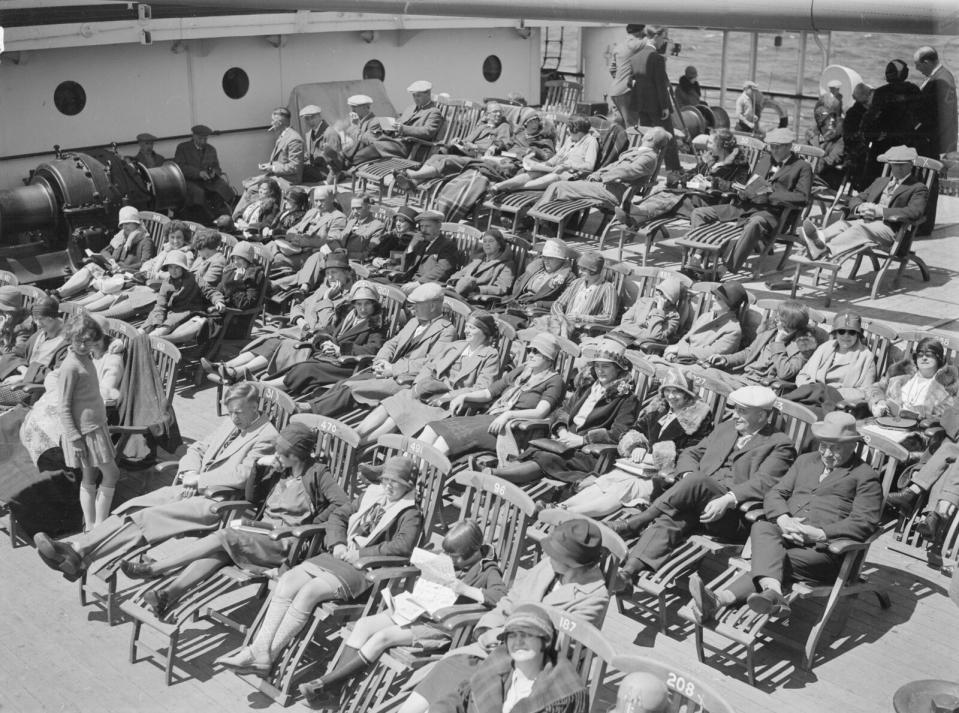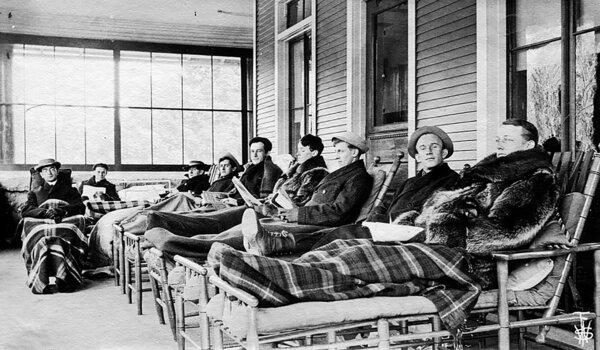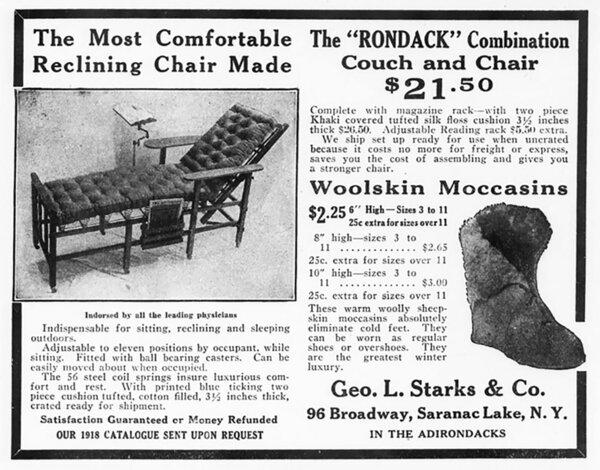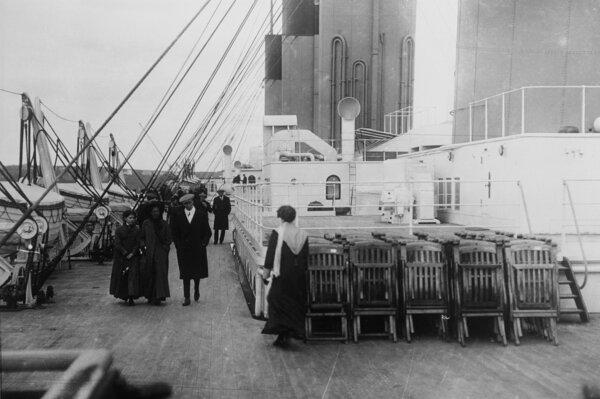Deck Chairs, Tuberculosis, and the Titanic: The Unexpected Origins of a Summertime Staple
- Oops!Something went wrong.Please try again later.
- Oops!Something went wrong.Please try again later.
Before the style of reclining outdoor furniture became a symbol of outdoor leisure, it was used for a very different purpose.

We tend to associate relaxing with "kicking back" and "putting our feet up"—terms we use to describe the act of sprawling out on reclining furniture like BarcaLoungers, Victorian fainting couches, and perhaps most ideally, poolside chaise longues and deck chairs.
But before reclining outdoor furniture—whether at a resort, the beach, or in your own backyard—became a summertime staple and symbol of the privilege of leisure time and self-care, early versions of what we today consider the deck chair were primarily used in two starkly different, and perhaps surprising settings: tuberculosis hospitals and ocean liners.
Cha(i)sing the cure
Tuberculosis was one of the leading causes of death in Europe and North America in the 19th and early 20th centuries. Up until life-saving antibiotics became widely available in the 1950s, the standard treatment was plenty of rest and a nutritious diet, combined with exposure to fresh air. From the mid-19th to mid-20th century, those who could afford to do so "cured" in dedicated tuberculosis hospitals known as sanatoria—the first of which was established in 1854 by Dr. Hermann Brehmer in the German village of Görbersdorf (now known as Sokołowsko in modern Poland).
In the late 1870s, across the Atlantic, a New York City physician named Dr. Edward Livingston Trudeau who’d been diagnosed with tuberculosis noticed his symptoms improved after he moved to the Adirondacks region (which has attracted affluent New Yorkers for luxe wilderness recreation trips since the Victorian era), and in 1884, he opened the Adirondack Cottage Sanatorium (and later the first U.S. tuberculosis research lab) in the town of Saranac Lake.
In Europe and the U.S., sanatoria were typically located far away from the pollution of rapidly industrializing cities—in the mountains, by the sea, in the desert—giving patients access to fresh air while they rested. Unfortunately, outdoor furniture of the era wasn’t designed to accommodate ill individuals spending entire days in repose. "When the TB industry started in Saranac Lake, the early pictures show people sitting in rocking chairs, or folding, upright chairs—sometimes with their feet propped up—and they look uncomfortable and cold," says Amy Catania, executive director of Historic Saranac Lake, a local architectural preservation nonprofit.
By the 1880s, most tuberculosis patients in Europe and the U.S. were spending most of their days "curing" outdoors in nonadjustable reclining lounge chairs made from bentwood or cane. Some doctors took it upon themselves to create modified versions for their patients, like Dr. Peter Dettweiler, an early Görbersdorf patient and later assistant to Dr. Brehmer, who opened his own German sanatorium in 1876, and designed adjustable cushion-topped bed/chair hybrids. Dr. Lawrason Brown, the resident physician at the Saranac Lake sanatorium from 1901 to 1912, used Dettweiler’s chair as a model to design his own version, the Adirondack Recliner (not to be confused with what we know today as the Adirondack chair, popularized for non-TB-related outdoor lounging), which was made and sold by local furniture store A. Fortune & Company. Between 1912 and 1921, at least four other Saranac Lake residents patented their own "cure chair" designs, some of which were sold across the U.S. and Europe.
According to Catania, sanatorium cure chairs "had to be comfortable—allowing people to change position, lying down at different angles," often while in heavy coats or layers of blankets, and they also "had to be mobile," meaning, able to fit through doorways of a house or sanatorium. Many chairs had built-in features like wide armrests for writing and reading, and some manufacturers sold add-ons and accessories like magazine racks and stoneware hot water bed warmers known as "pigs" (presumably for the snout resemblance).
Because Adirondack-style cure chairs were costly to manufacture and ship, some early-20th-century sanatoria provided patients with beds on casters that could be rolled between the indoor areas and open-air terraces; others relied on lightweight, folding wooden lounge chairs. The latter were a popular choice at turn-of-the-century sanatoria in warm, arid western states like Colorado, New Mexico, and Arizona, where those who came to "cure" often lived in colonies of canvas tents or small wooden shacks that required furniture to be compact and multifunctional.
But portable deck chairs weren’t only used in sanatoriums; many doctors of the era recommended outdoor "air baths" for patients at home, whether in their backyards or on their apartment rooftops. A century later, we’d recognize this as sunbathing in a lounge chair—minus the tuberculosis.
Full steam ahead
Like sanatorium patients, 19th-century ocean liner passengers also found themselves in confined quarters, trying to pass the time. When the first fully steam-powered transatlantic passenger ships were introduced in the late 1830s, most of the outdoor spaces were dedicated to the functioning of the ship—accommodating the smokestacks, guy wires, and auxiliary sails, and the people operating them—leaving those on board with little room to lounge or congregate.
"We think about deck chairs as being de rigueur for ocean crossings of any sort, but in the middle of the 19th century, the outdoor experience on ships didn’t really exist," says Daniel Finamore, curator of maritime art and history and associate director of exhibitions at Massachusetts’s Peabody Essex Museum.
Still, that didn’t deter passengers from finding ways to get fresh air on their voyages. "They would drag the interior furniture out onto the deck and try to find a spot where they weren’t in the way," Finamore says. It didn’t take long for shipping companies to pick up on this, and by the late-19th century, they started to develop their ocean liners’ exteriors, adding spaces like promenade decks for outdoor lounging.
Initially, passengers could travel with their own folding chairs—typically made of wooden frames with canvas or cane seats and backs—and ask the shipping company to hold onto them until their return passage. "The big shipping lines realized that was more of a hassle than providing chairs and charging people to use them in order to make up their cost," Finamore says. Once companies like Cunard, the White Star Line, and the Compagnie Générale Transatlantique (aka the French Line) started supplying rentable deck chairs, their designs evolved; most notably, through the addition of footrests (some removable), reclining backs, and a general move away from canvas and cane, toward wood slats able to withstand more wear and tear. (Picture the deck chairs recovered from the Titanic.)
See the full story on Dwell.com: Deck Chairs, Tuberculosis, and the Titanic: The Unexpected Origins of a Summertime Staple
Related stories:




